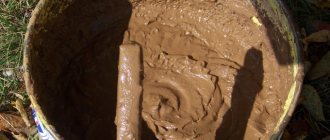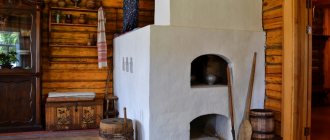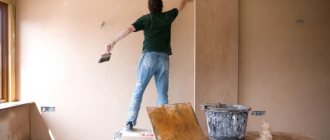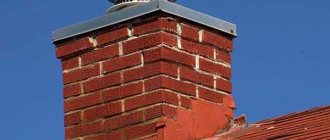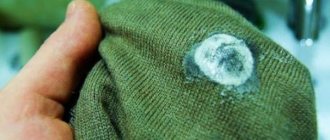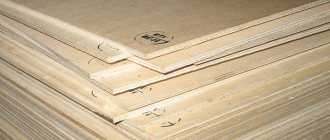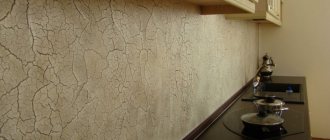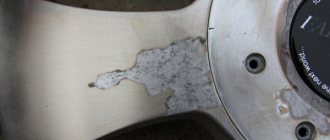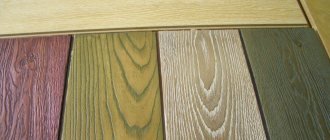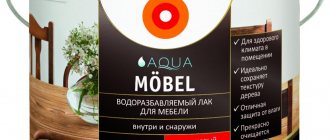Other ways to get rid of cracks
If you don’t want to spend a long time fiddling with putty according to a folk recipe, you can buy a special heat-resistant mixture at a hardware store, which you just need to dilute with water, and it will be ready for use.
However, follow the same rules: lightly heated stove, cracks moistened with water, do not heat until the solution is completely dry! If the solution doesn’t help or you don’t want to bother with it, you can do a more radical and very practical way - make a frame for the slab from a sheet of aluminum or other suitable metal. To do this, you will need several sheets of metal, squares (if there are none in the corners of the slab), and metal scissors. Measure the height of the slab and its sides, cut out the corresponding pieces of metal. If the tile is adjacent to the wall, then try to use a grinder to make a small indentation in the wall so that the sheet seems to fit into the wall.
To ensure that the sheets adhere perfectly to the stove, it is best to secure them on top and on the sides with squares. The angles should be on top of the metal elements. If the slab is already reinforced with angles, it is better to remove them, install sheets of metal and then return them to their place. The metal can be painted with heat-resistant radiator paint or left as is - if it is stainless steel, then it will look quite decent.
After a long winter, many go to the dacha for the first time this season and, getting ready to relax, light the stove in the house or in the bathhouse. And they are very surprised when they feel carbon monoxide entering the air in the room - after all, nothing like this happened last year. After a preliminary inspection, they are convinced that smoke has penetrated through the cracks that have appeared and immediately think about how to cover up the cracks on the stove.
After calling the stove maker, it turns out that there are many problems with the structure and it requires major repairs. Without telling you how to coat the stove, he immediately issues an impressive bill, which not everyone can afford to pay. In this article we will talk about the rules for troubleshooting problems of this kind, that is, we will figure out how to cover the stove so that it does not crack.
Fireclay clay – a synthesis of natural and human
Chamotte is a word borrowed from the French language, which has recently been heard with renewed vigor. Tired of unnatural delights and plastic gloss, people are striving for natural materials, among which fireclay occupies a prominent place. However, it is not possible to obtain such a material without human intervention - special white kaolin clay must be fired in rotating kilns at a temperature of about one and a half thousand degrees Celsius, since it is in such extreme conditions that it completely loses its plasticity and loses all the water associated with its molecules .
Thanks to this, fireclay acquires properties close to those of stone. The resulting pieces of fireclay are crushed in special mills and already in this form go on sale in the form of dry construction masses or are used for the production of fireclay bricks. It should be noted that not only builders, but also designers are partial to fireclay. Fireclay clay has some inexplicable restrained beauty, a special texture, a natural spirit, thanks to which things made from this material can decorate even the most sophisticated interior, so this method of use is not at all uncommon. In a creative environment, ceramic dishes, tiles, and figurines are made from fireclay clay.
Builders, in turn, are trying to use textured fireclay not only for cladding surfaces exposed to high temperatures (the same fireplaces and stoves), but even for the facades of houses!
Fireclay clay is also found in construction stores under the name kaolin - the essence does not change. The color of this material ranges from white with cream shades to gray-brown. Fireclay is actively used both for creating mortar for laying bricks, for mixing brick mortars, and for carrying out plastering work. When purchasing, make sure that the clay has not been sitting on the shelves for a long time - otherwise it could lose its properties, because stores do not always maintain the conditions it needs. Prolonged exposure to humid air can completely ruin fireclay, just like what happens with cement. Using such material is more expensive.
How to seal on metal stoves
The need to seal the stove appears when cracks form in the seams and bricks, causing smoke to enter the living space rather than exit through the chimney. To save money, it is better not to call a specialist, but to do the finishing yourself. The procedure does not require special skills and will not take much time.
Smoke may not escape through the chimney due to soot accumulation or if the stove has not been used for a long period. Cleaning and warming up will help improve heating in the house. If the problem persists, the cracks should be covered.
One of the reasons for smoke entering a living space may be cracks that appear, which are formed for the following reasons:
- poor quality solution;
- improper finishing;
- gross violation of the technique of use;
- uneven heating of the structure;
- drying of materials.
If the problem is an incorrectly made foundation, then drastic measures may be required, including disassembling the furnace.
However, with minor cracks, you can simply coat the stove, after first removing the lining and plaster from the bricks. The best options for putty are clay mixed with sand, glue and grout.
Materials should be selected based on the extent of damage and financial capabilities.
One of the options for solving the question of how to repair cracks in a stove is tiling. Moreover, you can use clinker tiles, porcelain stoneware, terracotta or tiles. If you follow all the subtleties of working with these materials, you can forget about stove repair for a long time.
However, this option is not available to everyone, since such finishing materials are quite expensive. Therefore, there is a budget finishing option - plastering the surface
Moreover, it is very important to know how to rub the stove so that it does not crack.
The problem of how to cover up cracks in a metal stove can be solved by welding. However, if this is not possible, they resort to recommendations for making putty that is resistant to high temperatures.
Aqueous solutions can be prepared from the following ingredients:
- 30 parts clay, 4 parts metal filings, 2 parts manganese dioxide, 1 part salt, 1 part borax.
- 10 parts magnesite and 3 parts liquid glass.
Drying oil-based solutions are prepared from the following components:
- 4 parts clay, 2 parts zinc white, 1 part manganese oxide.
- 12 parts graphite, 4 parts lead and 3 parts chalk.
For flawless operation of the stove, it is necessary to carefully consider not only its design features, but also choose materials that will maintain heat in the house.
If a metal stove begins to crack, welding is the best solution to repair it. If it is impossible to use this option, you can prepare a heat-resistant mixture for filling defects:
- A solution based on clay with the addition of metal filings, manganese dioxide, salt and borax in proportions of 30 to 4: 2: 1: 1
- A mixture of liquid glass and magnesite in a ratio of 3:10. Also, based on liquid glass, a mixture is made of two parts of manganese oxide, zinc white and one part of borax. Glass is added until the desired consistency is obtained. Whitewash is used in dry form.
- Colloidal sulfur, metal filings and ammonium chloride are mixed in a ratio of 1.5:96:2.5.
- Based on natural drying oil: you will need graphite, lead, manganese oxide in a ratio of 5 to 1 to 1. Lead is used in the form of calcined oxide. Another solution with graphite, lead and chalk is diluted in a ratio of 12: 4: 3. Eliminating cracks on a metal surface
How to cover up cracks?
For these purposes, you can use several options that will reliably seal cracks in the walls and prevent gas from escaping into the room. Let's look at each method in more detail.
Fireclay clay
Before you cover cracks in the stove with fireclay clay, you need to know its advantages:
- the material is resistant to temperature during fuel combustion;
- high level of vapor permeability;
- resistant to moisture when heated;
- environmentally friendly material, safe for humans and animals, therefore can be used in residential premises.
To make the solution you will need to mix several ingredients:
- 1 part cement grade 500;
- 2 parts fireclay clay"
- 7 parts river sand.
The solution is mixed well and water is added. The consistency depends on the skill and type of work, but you should not make it very liquid or thick. To get rid of stones and lumps, the clay can first be soaked in water for several hours and the lumps of material can be crushed, and the cement and sand can be sifted. Such a solution will be plastic and laid on the surface in an even layer.
Plastering walls is easy if you have a certain skill
To do this, it is important to install beacons and, distributing the solution, level the layer on the wall. You will need to prepare a trowel or spatula, the size of which depends on the surface area
Clay and sand
This is the most affordable, inexpensive solution for plastering surfaces. Such a solution for the oven has sufficient plasticity and is not subject to destruction under the influence of high temperatures.
It’s easy to prepare the solution for use; for this you will need:
- prepare a large trough in advance, add the required amount of clay and completely fill the layer with water. For 1 bucket of clay, pour 3 buckets of water. The clay should soak for 24 hours;
- then mix the solution and add more water to it. We pass the slurry through a sieve, get rid of lumps and let the solution settle;
- drain the excess water, making the solution as thick as homemade sour cream;
- add river sand in a 1 to 1 ratio and mix the solution.
Expert opinion Pavel Kruglov Stove maker with 25 years of experience
Important! At this time, you can determine the quality of the solution. Having lowered the shovel holder into it, and seeing the adhering clay - in this case, you will need to add a little sand
Only after seeing small clumps of sand and clay solution on the holder can you start plastering the walls of the stove.
With this solution it is necessary to repair all cracks that appear, after wetting the surfaces and then plastering the stove in several layers. In villages, they still use the old method, adding horse manure to the prepared solution. This solution is obtained with increased thermal insulation properties. Hay plays the role of air layers that prevent the free passage of heat.
Grout
This oven putty is sold ready-made, but it’s easy to make yourself. The main advantage of this material is the ability to retain its properties even when heated to 10,000. Industrial materials are used for arranging and repairing stoves and fireplaces, but the price of such grout is high, so home craftsmen do it with their own hands.
The mixture for coating the oven is made in several stages:
- knead large lumps of clay and pour it into a trough;
- fill it with water and leave for 10-12 hours;
- pour part of the sand into the soaked clay, maintaining a ratio of 1 to 4, mix the solution well, adding 5 parts of chopped straw in small portions;
- Add 1 kg of coarse table salt to the finished putty and finally mix the solution.
The finished grout can be used to fill gaps between bricks, crevices, cracks and complete the first rough layer of plaster.
Furnace glue
In order to repair a cracked stove, you can buy heat-resistant special glue at a hardware store. Due to its properties, it is not exposed to high temperatures for a long time. It consists of the addition of fireclay clay and cements with high fire-resistant properties.
A plastic and hard adhesive mixture is produced. Using hard materials, the surfaces of the stoves are plastered. Plastic glue is used to fill cracks and seams between bricks.
When using this material, you must follow the instructions when diluting and using the heat-resistant substance. You should not make it in large portions; it dries out quickly and becomes unsuitable for work.
We inspect and select material
Before you begin, determine the extent of the damage. Even if small cracks appear, all old mortar in this place should be removed right down to the brickwork. The cleaned area should be covered with a solution, but what should you use to cover the stove so that it does not crack? This question interests many, and there are the following options for building mixtures that are most suitable for brick kilns:
- clay and sand;
- construction grout for stoves;
- fireclay clay;
- oven glue.
The simplest and most economical option is clay-sand mortar, which was still used by our ancestors. The quality of clay coating is not inferior to modern mortars, but it is much cheaper. Any clay is suitable for oven mortar; it is desirable that it contains no foreign impurities. The clay is placed in water for 12 hours, after which it becomes plastic and homogeneous.
You can buy fireclay clay at the construction market. This material is specially designed for creating fire-resistant elements, bricks, blocks, and is also used for laying stoves. The material, like products made from fireclay clay, is distinguished by high quality, fire resistance and durability. Fireclay clay is inexpensive in hardware stores and is sold in 20 kg bags, with instructions for use included.
To analyze the condition of the stove you do not need to have the professional skills of a builder or stove maker. The main thing is to detect all cracks and assess their size. If there are no major defects in the masonry, then removing the old coating and applying a new one will be sufficient. In addition, you need to remove part of the mortar between the bricks in the place where the crack formed. After these procedures, the masonry is covered with mortar so that the patches are not noticeable.
Clay + sand = classic oven coating method
The use of clay in the construction and repair of stoves is a traditional method. This material has universal qualities - plasticity, viscosity, and when fired - strength, fire-resistant properties, durability. Sand acts as a fixative; it protects against cracking and spalling of the hardened mortar from the masonry.
Solution preparation technology
In order to properly prepare a refractory mortar, you will need equal proportions of clay and sand. But first you need to work on the clay - fill it with water (1 part clay, 3 parts water), leave to soak for at least a day. To do this, it is convenient to use large dishes, for example, a barrel. Next, the clay solution is mixed and kneaded, adding water if necessary, filtered on a medium-sized sieve (3x3 mm) and settled. Afterwards, drain the water and work with the prepared purified clay, which should resemble sour cream in thickness. Now it is necessary to determine the need for clay in sand, for which these natural substances are mixed in small quantities in a 1:1 ratio, the composition is thoroughly mixed and its quality is checked
To do this, you need to pay attention to the stick with which you mix the solution - if there is a lot of clay on it, then the solution is greasy and you should add sand, but if a few clots stick, then it is suitable for the job. Sand should be added 0.5 parts at a time so as not to make a mistake with the proportions of the components.
Thus, it will be determined that to prepare a high-quality solution for 1 part of clay, for example, you need 2.5 parts of sand. This is the main stage of the work, since a properly prepared composition will not subsequently crack, tightly holding the damaged area of the furnace.
Additionally, you can conduct another check. From the thick solution, make a ball about 5 cm in diameter and a cake with a diameter of 10 cm and a thickness of 1 cm. The products are left at room temperature until dry and observed whether cracks appear - there should not be any. And the ball should not disintegrate when falling from a meter height. In this case, this is the ideal material for the job. If there are cracks, then you need to add more clay.
Before applying the solution, the oven must be further strengthened. To do this, it is wrapped in gauze soaked in clay “milk” and the frame is allowed to dry thoroughly. Now you can start plastering.
Decorative heat-resistant plaster. How to cook it yourself?
In order to hide unevenness, plaster is used to prepare the surface for painting. Its decorative varieties can be used as independent decoration.
Carefully! A special feature of plaster for fireplaces and stoves is its constant exposure to heat. This eliminates the possibility of using conventional cement mortar - when exposed to heat, cement expands and cracks, and also releases toxic substances
For plastering heating appliances, it is preferable to use the following solutions:
- based on clay and lime;
- based on clay and sandstone;
- based on lime and gypsum.
Clay is the most popular material for making mortar due to its high thermal conductivity. To create clay-based plaster, mix clay soaked in water with sand in a 1:2 ratio. The composition should be of medium thickness, mix well, but be plastic. To improve the properties of the solution, asbestos and lime are added to it; in some cases, the addition of cement is allowed.
Photo 1. The process of plastering a brick stove using clay mortar. You can cook it yourself.
To quickly check the quality and plasticity of the knead, a rope with a diameter of 1-2 cm is rolled out of it, after which it is wound on a suitable stick (about 5 cm in diameter). If the tourniquet does not break, if it can be pulled out a little, the consistency of the solution is good. You can form small balls or cakes and dry them in the sun or using a heating device - a properly mixed solution will not crack.
Well-known manufacturers of plaster mixtures
The modern market offers many varieties of ready-made dry mixtures for plastering stoves:
- "Terracotta". The mixture consists of dry clay, fireclay dust, and binding elements. It is distinguished by its plasticity and strength, retains its properties when heated to 200 degrees, and is environmentally friendly.
- "Plitonite". It contains an additive in the form of strength-enhancing fibers, can withstand heating temperatures up to 400 degrees, and is suitable for preparation for painting and finishing.
- "Stove maker". In addition to clay, the composition includes lime and asbestos, gypsum, and mineral additives. The mixture is elastic and amazingly durable after drying; this plaster retains its properties even at temperatures up to 600 degrees. Its disadvantage is additives that cannot be called environmentally friendly.
The use of ready-made mixtures allows you to significantly save time on work and get a high-quality result.
How to properly coat an oven
Furnace repair has its own peculiarities. It is better to do all the work in stages. Here are some tips:
- Remove all the plaster at the crack site, widening it and deepening it up to 1 cm. This technique will increase the size of the repair surface that needs to be filled with mortar, which will significantly improve the quality of its adhesion to the furnace wall.
- Coat all prepared areas with water or primer. Then heat the oven, drying the entire surface thoroughly.
- While the stove cools, the repair areas are coated with a thin layer of clay solution.
- For greater practicality, you should use burlap or reinforcing mesh, which is attached with self-tapping screws.
- The prepared working solution is applied in a small thickness, in two layers.
- The oven must not be used until the solution is completely dry.
Why plaster the stove?
The answer to the question of when and why it is necessary to plaster a stove is very important. Having understood it, you can accurately decide whether this process is really necessary or whether decorative finishing from ceramic or fireclay tiles is sufficient.
There are several reasons that necessarily require plastering of surfaces:
- The stove was built a long time ago, and the old plaster was partially cracked and began to peel off. As a result, bare areas look unattractive.
- There is a risk of carbon monoxide leaking into the cracking masonry joints of an old stove.
- During the renovation process, it is necessary to change the style of the overall interior, as a result of which the stove needs to be given a more neat appearance or completely transformed.
- There was a need to treat the seams between the rows of bricks, in which settlements of various insects were found. This happens when solutions based on natural materials are used for laying the stove. Plastering the stove prevents the appearance and reproduction of insects.
- The masonry of the stove is not done carefully, which spoils the appearance of both the structure and the entire room. With the help of plaster you can completely solve a problem of this kind.
If we compare plaster with other types of finishing materials, we can note several advantageous points:
- Plastering is the simplest and most affordable way to put the stove in order.
- The mixture for plastering the surface is much cheaper compared to ceramic tiles or stove tiles. This allows you to significantly save material resources.
- The plaster mixture can be used to finish a newly built stove or to reconstruct an old building element.
- The applied layer of plaster makes the walls of the furnace thicker, therefore, the heat capacity coefficient of the structure increases. As a result, the furnace takes longer to cool down, resulting in reduced fuel costs.
- A plastered stove becomes less fire hazardous, and the risk of carbon monoxide entering the room is also reduced.
- After the plaster mixture has dried, you can use various materials to finish the oven. This can be water-based paint, lime mortar or decorative plaster.
What is fireclay clay
Fireclay is the most environmentally friendly refractory raw material. Before you figure out how to work with it, you need to find out what this building material is and what advantages and disadvantages it has.
Fire clay consists of elements such as quartz, alumina ceramic, calcium oxide, iron oxide, sodium oxide and magnesium oxide
What does it consist of and what does it look like?
The primary basis of fireclay is kaolin clay, which is formed as a result of the settling of particles of destroyed rocks. A mass of gray kaolin clay is subjected to heat treatment at high temperatures - about 1300-1500 C o, as a result of which it loses almost all the water that holds its molecules together, and the clay sinteres. After this treatment, kaolin acquires a brown tint and, in terms of physical properties, becomes similar to stone. Fireclay is brought into its finished form using metal rollers, which crush pieces of burnt kaolin.
The higher the firing temperature of kaolin clay, the less water remains in the fireclay composition, due to which the material loses its plasticity and does not undergo dramatic physical and chemical changes when exposed to heat. In other words, due to the loss of water, fireclay practically does not expand when heated. Based on moisture absorption, fireclay is divided into:
- Highly annealed. Water absorption – from 2 to 8%.
- Low-burnt. Water absorption – from 20 to 25%.
Water absorption is the amount of moisture that a material can absorb and retain in its pores. This characteristic is expressed as a percentage as the difference in the mass of dry material and that saturated with moisture. For example, if a dry material has a mass of 1 kg, and a fully saturated material (it is unable to absorb more liquid) weighs 1100 grams, then its water absorption is 10%.
All types of fireclay clay can withstand approximately the same temperature, at which they are not subject to its destructive effects - 1800 C o. The maintained temperature depends on the final material in which the fireclay powder was used: the concentration of clay, water, retaining agents and other chemical reagents in it. Manufacturers may (but are not required to) list the exact maximum operating temperature of the clay on the bag, along with detailed mixing ingredients.
Fireclay clay is excellent for laying fireclay bricks, since both materials have the same coefficient of linear expansion
Clay also has another characteristic - moisture. The higher it is, the more plastic the material is, and therefore the more sensitive to thermal effects. Humidity, as well as the maximum temperature, may be indicated on the packaging, but usually this characteristic is not paid attention to, since the difference is small - from 4 to 7%. In addition, fireclay differs in particle size: fine-grained is used for adding to bricks, and coarse-grained is used for decorative finishing.
What is it for?
Fireclay clay is a material with a wide range of uses. Its thermal resistance is especially valued in construction, and its beautiful brown color and unusual texture are valued in interior design and artistic modeling. The main areas of application of fireclay are:
- Creation of fire-resistant building materials;
- Decorating the room using fireclay plaster;
- Modeling of figurines and souvenirs from fireclay mass with special impurities.
Fireclay brick is fireproof and is marked with the letter “Ш”
Fireclay powder is added to cement mixtures, putty, and can also be used as a base for bricks. As a result, such a product acquires fire-resistant properties, but its price also increases significantly. Refractory bricks (“Ш” - this marking must be present on them) are capable of withstanding one and a half thousand degrees, thanks to which they serve as the main material for furnaces, but it makes no sense to lay out the entire structure from them, since it will cost a pretty penny. It is important to note that for fireboxes it is necessary to use not only refractory bricks, but also fireclay mortar to connect them.
Due to its texture, fireclay plaster is suitable for modern interior design as an independent artistic tool - you can see that it is used not only to remove unevenness, but also simply to decorate the surface.
Ceramic dishes and decorative figurines are made from fireclay clay.
If you add additives to fireclay clay, including water, moisture-retaining reagents and plasticizers, it will become a pliable material for hand modeling. From such a mixture you can sculpt not only a figurine or decorative figurine, but also artistically design a frame or a small piece of furniture that can be fired in a kiln. The higher the baking temperature, the darker and more fragile the shapes are. After baking, they can be glazed and painted.
The stove is cracked - we determine the reasons!
Cracks and fissures stretch across the surface of the stove like a spider's web, especially if you heat it up on frosty days. The problem is not new, so there are plenty of solutions, you just need to wisely choose the right one depending on a particular situation. First you need to understand the causes of cracks. By and large, there can be three of them - poor-quality putty, hasty finishing of the furnace without complying with standards, and subsidence of the furnace itself.
The stove can sag due to an incorrectly laid foundation or poor-quality brick. The most radical way to solve the problem is to disassemble the stove, strengthen the foundation and put it back together. However, you should act in this spirit if the drawdown is really significant, smoke pours out of the cracks during the fire, the doors no longer close tightly, and the brick inside the stove itself is crumbling. With such “symptoms” it is necessary not only to disassemble it, but also to assemble it from completely different materials.
However, if we are talking about small cracks, you still shouldn’t rush - subsidence of a new furnace in the first few years is acceptable. What you should not do immediately after installing the stove is tiling it. Of course, it’s beautiful and practical, but when it starts to fall off as a result of subsidence, you’re unlikely to enjoy sweeping up the fragments and gluing everything back together. Therefore, do not rush - let your stove warm up properly for a year or two, and if cracks do not appear, then lay the tiles.
Tiling is often recommended as a solution to crack problems. But at the same time, summer residents forget that the stove can crack even under the tiles. And everything may look fine, but smoke will penetrate into the room through these cracks, and this is already fraught with consequences. Therefore, tiles are good only in cases where the stove has been checked and certainly will not crack.
Instructions for use
The approximate consumption of fireclay clay during masonry is 25 bricks per 20 kg of dry mixture or 100 kg of mortar per 1 m 3 of masonry. You can prepare the solution yourself using a relatively small list of materials and tools. It is very important to perform all actions consistently, since otherwise the composition will be of poor quality, which will lead to rapid destruction of the masonry, which is especially dangerous in conditions of open fire.
How to dilute fireclay clay for laying a stove
It is impossible to use only fireclay sand for the composition due to poor ductility. It must be diluted with another suitable material: for example, ordinary clay or purified kaolin. In the first case, the ratio of products should be 2:1 (the first number is fireclay sand), and in the second - 4:1. There is no particular difference, other than the consumption of materials, between the options for adding either ordinary clay or kaolin.
It is very important to understand that ordinary sand cannot be used to prepare fireclay composition, since it expands when exposed to heat and exposes the masonry to gradual destruction. In addition, sand does not combine well with the components of the composition, which significantly reduces the service life of the masonry and reduces its reliability. Portland cement can be found as a special additive in fireclay mixtures. If the temperature in the furnace firebox does not reach high temperatures - above 700-800 C o, then its use is advisable, since Portland cement increases the strength of the mixture, but reduces the fire-resistant properties. In addition, a small amount of fiberglass chips can be added to the composition to give it strength.
The approximate procedure for preparing a mixture using kaolin is as follows:
- From the above ratio, the required amount of kaolin sand is derived. It is sold in exactly the same bags as fireclay sand, only it is not brown, but white. It is kaolin sand that will serve as the basis for the mixture along with fireclay.
- Fireclay sand is mixed in the same container with kaolin sand and gradually diluted with water. At this time, it is important to stir the mixture to distribute the water molecules between the molecules of the substance. At this stage, the mixture is prepared according to the approximate ratio. Water should be added in small portions so as not to spoil the composition. When the required amount of water has been added, the mixture must be left for three days so that it can absorb all the moisture and acquire the desired consistency, which should be similar to the consistency of sour cream.
- After the period has passed, you need to check the quality of the resulting composition and its thickness. If it is too liquid, then a mixture of kaolin and fireclay sand is added to it in the same ratio - 2:1, but if it is too thick, then water is added in small portions.
- The surface on which work is planned must be treated. For this, a special plastic construction mesh and a small spatula with fire-resistant putty are used. The surface to be treated is covered last: a layer (or several layers) of mesh is placed on top, after which another layer of fire-resistant putty is applied to the surface. When the surface preparation work is completed, you need to wait for the putty to dry.
In the store, fireclay clay can be bought in a twenty-kilogram bag, which is enough to lay up to 30 bricks
It is important to note that the layer of composition should not be very large, since in this case the heat will be slowly removed and accumulate in the walls of the firebox. This will lead to the fact that the side that is closer to the flame will be heated much more than the one further away, which will cause a difference in the speed of movement of molecules in the substance, and it will become covered with cracks. The larger the layer of compound between the bricks, the higher the likelihood of a sad outcome, so you need to ensure that there is no more than 2-3 cm of fastening compound between the bricks. In this case, this will not only reduce the consumption of the mixture, but also extend the service life of the masonry.
How to prepare a solution for plaster
From fireclay, you can make not only compositions for fire-resistant masonry, but also plaster for the design and repair of walls or as an intermediate fastening link between the wall and the facing material. In addition, fireclay plaster is used to give additional reliability to the stove masonry - it is used to treat the working surface to improve the adhesion of the low-plastic mixture to the surface. Fireclay putty is also used to cover the back walls of stoves, which, as a rule, open into other rooms, to create a barrier for heat and reduce heating of surfaces.
Chamotte mortar is recommended to be used in cases where it is necessary to obtain a perfectly flat surface
Types of mortar for plastering stove walls
The stove is one of the building elements that regularly heats up and cools down, so the chosen plaster composition must be resistant to this phenomenon.
Mixtures for preparing plaster mortar are divided into two types:
- Simple compositions that include only two components, sand and clay.
- Complex formulations contain more than two ingredients.
Plastering a stove with clay and sand requires preliminary preparation and cleaning of the materials from various impurities. In particular, sand must be sifted through a fine sieve, clay should be rubbed through a fine mesh to remove roots and small stones.
It is recommended to make the plaster mixture using fatty types of clay, this promotes better adhesion of the solution to the surface. If the clay is too oily, the amount of sand used can be increased.
In some cases, asbestos, finely chopped straw or fiberglass are added to the mixture for plastering the stove. These reinforcing components make it possible to obtain more durable materials.
When preparing plaster mixtures, special attention must be paid to the environmental side. During the heating process, the materials used should not emit substances that pose a danger to human health and life.
Separately, it should be said about salt; it is also sometimes added to the solution for plastering the stove. It should be noted that the opinion that salt makes it stronger can be considered erroneous. In fact, salt increases the hygroscopicity of clay, making it more flexible and resistant to cracking. Also, a plastering solution, to which a certain amount of salt is added, prevents the proliferation of various insects in masonry joints. For owners of private houses, this fact is of great importance.
Another component that can be added to the plaster mixture is gypsum powder. This material is used as a fixative
However, plaster must be used very carefully, as it hardens very quickly. The initial setting of the solution with the addition of gypsum powder occurs immediately after application, and after 10-15 minutes the surface hardens completely.
Advantages and disadvantages
This material does not cause controversy both among professional builders and among those who like to do household work with their own hands, since it is practically indispensable in the manufacture of stoves and various fireboxes. Fireclay clay does not have any obvious disadvantages, but this does not exclude its negative properties. The advantages of the material include:
- Excellent heat resistance;
- Reliability and long-term durability during professional masonry;
- Environmental friendliness of the material;
- The presence of micropores for the passage of steam, which also prevents the expansion of the masonry and its destruction;
- High level of adhesion.
There are fewer disadvantages, and besides, they are typical for many high-quality materials:
- High cost, since the production of such clay is technologically more complex and dangerous than the production of ordinary building clay;
- Fireclay dust enters the respiratory tract, so it is necessary to use a respirator when working.
Adhesion is a physical process of sticking together of dissimilar bodies under the influence of intermolecular forces.
How to cover up cracks?
You can cover the stove with a purchased mixture or a solution you prepare yourself. Further about the features of the options.
Sand-clay mixture
Putty made of clay and sand is the most accessible and inexpensive option. Scheme for preparing the mixture:
- you need to take clay and fill it with water in a ratio of 1:3; after this you need to leave the mixture for at least a day;
- The clay should be thoroughly mixed, adding liquid from time to time; after kneading, strain with a fine-mesh sieve and tincture again (several hours);
- after the next infusion, you need to drain the water and make sure that the mass has a creamy consistency;
- you need to mix clay and sand - first in equal proportions.
Readiness is determined using an object used to mix the solution. If too much clay sticks to it, add a little sand. As a result, the ratio of components can be from 1:1 to 1:2.5. The composition can be considered ready when a small amount of the viscous component remains on the stick.
This recipe is approximate as clays can vary greatly. It is best to rely not on a stick with stuck clay, but on the result of experiments. Experienced craftsmen make grout with different compositions. After this, several different types of cakes are dried in a place free from sun and wind. Those pieces that are not cracked are dropped from a meter height. “Surviving” flatbreads demonstrate the optimal ratio of components.
Fireclay putty
Bag of fireclay clay
A slightly more expensive, but also more effective option. Fireclay clay is very heat-resistant and durable. Most often, fireclay is used for stove repairs. The material is sold by construction stores. Before sealing the structure, purchased clay is infused in water for a couple of days.
Oven adhesive
If you need the best option, use a special mixture for ovens. The solution consists of fire-resistant cement and fireclay powder. There are two main types of glue you can buy in supermarkets - viscous and hard. If you are looking for something to cover up small cracks on the stove, purchase the first type. Solid mixtures are used for plastering.
The main advantage of factory materials is the optimal ratio of components and very thorough mixing. It is impossible to achieve such quality at home. In addition, there is no need to waste time preparing grout. Another advantage of ready-made compositions is quick setting.
An alternative option is oven grout.
Factory solutions are good for everyone, except for the price. There is another opportunity to save money - use putty prepared according to the following recipe:
- the clay is broken into small lumps and infused in water for about 12 hours;
- sand is added to the mixture of water and clay, after which the components are thoroughly mixed;
- during the mixing process, crushed straw is added to the composition from time to time, which reinforces the solution;
- After the mixture becomes homogeneous, salt is added to it (about a pack).
The ratio of sand and clay is 1:4. You need about 10-15 kg of straw per bucket of clay. It is easy to see that this is a modified version of the sand-clay mixture described above.
What kind of putty should I use?
Clay and sand
Covering cracks with a clay mixture is the most economical and easiest way to restore a stove structure.
You can take any clay . It is important that it contains a minimum amount of impurities. If the raw material is of high quality, then after soaking it should have an oily, homogeneous and, most importantly, plastic structure
At the same time, the quality of restoration is no worse if the stove was repaired using expensive modern means. Before you start covering with clay, you should understand the features of preparing the solution.
How to make clay putty yourself
The preparation of the mixture is done in stages.
- Before mixing the components, the clay must first be kept (soaked) in warm water for 12 hours.
- Knead the softened clay until smooth so that there are no lumps left in it.
- To obtain a mixture for putty, you need to take clay and sand in a ratio of 4:2, respectively. The last component should be pre-sifted. The amount of liquid is taken depending on the moisture level of the components.
- If you want the stove to be white, add lime to the putty and knead everything thoroughly until a homogeneous consistency is obtained. The prepared mixture is covered with polyethylene and kept for 12 hours.
- The settled compound is kneaded a second time. Roll a piece of putty into a ball in your palms and squeeze it. If it starts to crack, you need to add water to the mixture.
- Lightly heat the oven, spray water into the cracks, and then start caulking.
- To prevent new defects from appearing, straw is added to the clay. A more reliable method is to use a plaster mesh. If the solution is applied to a surface covered with this material, you will forget about cracks for a long time.
Fireclay clay
Fire clay is often used to repair old stoves. The material has increased fire resistance. Furnace structures finished with it are durable. This material is sold in all construction stores and markets in 20 kg bags. It's inexpensive. The working mixture is prepared strictly according to the accompanying instructions placed on the packaging.
Grout
As a putty for brick stoves, you can use grout designed specifically for this purpose. Various similar formulations are sold in stores. They are expensive, but they are the best option for lining brick stoves, as well as fireplaces. If you are on a budget, prepare this remedy yourself. To do this you will need clay, sand, water, straw and salt. The clay should be thoroughly kneaded and filled with warm water. After 12 hours, add sand four times less than the first component to the mixture and knead, gradually adding finely chopped straw, not forgetting the salt. For four buckets of clay mixture, take 50 kg of chopped straw and a package of salt. The resulting composition can withstand temperatures exceeding 1000 degrees. Celsius.
Furnace glue
To prevent the formation of cracks in the stove structure, heat-resistant glue is used. This is a ready-made building material used for lining fireplaces. Sold in all construction stores and markets. Its main properties are heat resistance and durability. The adhesive composition consists of fireclay flour and cement with fire-resistant qualities. Glue for stoves can be soft or hard. The plastic product is used to seal cracks. The second is for plastering the surfaces of the stove. The main advantage of the glue is its almost instant drying. Therefore, it needs to be mixed in small quantities.
Sealing cracks and crevices on the stove
In order to cover up cracks and crevices, the following types of solutions can be used:
- Using a solution based on refractory clay. PVA glue and water are added to this solution. The proportion of the mixture for filling cracks is as follows: add 0.15 kg of PVA glue to 5 liters of mixed clay with water. Mix the solution thoroughly until a homogeneous consistency is obtained. Before covering a crack, its surface must be cleaned of dirt and dust and moistened with water. After this, you can cover the crack with the resulting solution.
- The second solution, suitable for sealing cracks, is prepared based on cement and clay. This option is more durable. This mixture is suitable for sealing small cracks on plastered surfaces. The ingredients for this mortar are: fire clay, cement, sand and asbestos. Mix from in the following proportion – 1:1:2:0.1. All components are thoroughly mixed, gradually adding liquid.
Properly prepared solutions lie smoothly on the surface. After such mixtures have dried, it will be enough to sand the surface with sandpaper. It is recommended to use fresh solutions immediately after preparation. Before applying the mixture, the surface must be moistened. This will help the material to better adhere to the surface being repaired.
If all proportions are correctly observed, work technology and the use of high-quality materials, the repaired structure will have a service life of at least 10 years.
Source: tvoykirpich.online
How and with what should I cover the stove so it doesn’t crack? Video
To prevent the stove from cracking, it is covered with clinker or some other tiles
An option to solve the problem is to finish the outer surface with ceramic tiles. The material will last a long time if technological recommendations are followed.
Types of tiles used:
- porcelain stoneware;
- types of tiles;
- clinker material;
- terracotta
You can seal the stove to prevent it from cracking using a clay solution. The mixture adheres well to the surface, and cracks rarely form.
The stove surface is processed using the following tools:
- Putty knife. Several varieties are used for ease of coating.
- Hammer for driving nails under plaster.
- Trowel. Used for mixing the solution and applying the mass to the surface.
- Metal scissors. The tool is needed to cut metal plaster mesh.
- Grater. Used for grouting mortar.
- Ironing iron. Using the device, the plane is leveled to an ideal state.
- Chisel. Used to notch the caulking area for better adhesion.
- Brushes. For wetting the surface.
- Construction level, plumb. The tool is taken to level the plane in a horizontal or vertical position.
Over time, the operation of the stove leads to the formation of cracks. The reason for the appearance of cracks is uneven heating of the stove masonry and the evaporation of excess moisture on its surface.
Cracks on the Russian stove
When cracks form on the surface of the stove, it is necessary to answer the question of how to cover the stove and how and with what to cover the seams in the stove, in places where cracks have formed on its surface. There is no doubt that the material with which the stove must be coated must be fireproof, easy to apply to the surface of the stove and have good adhesion to the edges of cracks.
Cover the stove with clay
So, how to cover the stove with clay.
The simplest and most proven material used for filling cracks and crevices on a stove is traditional clay, with which a classic solution for filling cracks in a stove is prepared.
This solution consists of a mixture of clay and river sand in a 1:1 ratio. This solution is thoroughly mixed to avoid lumps. Moreover, it is recommended to pass this solution through a metal sieve with large cells.
To check the strength of the resulting solution, you should make a ball out of it and throw it on the floor. If cracks form, a little more clay must be added to the solution.
To do this, it is recommended to fulfill the following condition: To avoid the formation of cracks on the stove during its operation, it is recommended to wrap the stove lining with gauze soaked in a liquid clay solution and allow it to dry.
In order to cover the stove with clay you will need the following tools and equipment:
- container for preparing the solution;
- a ladle for applying the solution to the surface of the furnace;
- rubbing to level the solution;
- Master OK.
To seal cracks and crevices in the furnace, non-traditional solutions are also used, consisting of the following components:
- clay;
- sifted river sand;
- horse manure or chaff (seeds from sifting grain).
According to the advice of experienced stove makers, this mixture must be kneaded with your feet. When mixing this solution, care must be taken to ensure that no lumps form. The readiness of the solution is checked in a simple folk way - if the leg pulled out of the solution remains clean, then the solution is already ready. You will also be interested in familiarizing yourself with the types of dry construction mixtures.
- The resulting solution must be covered with oilcloth and left overnight, after which it must be mixed again. Before using this solution, the surface of the oven must be moistened with water, and it should be laid in two layers, allowing the first layer to dry before laying the next one.
- After coating the stove is completed, let it dry for at least two weeks, and after that, you can begin plastering it with a solution of river sand and starch. After the stove has completely dried (approximately within a month), you can apply lime whitewash with color additives to the stove at your discretion.
Mixture-solution for sealing the stove
A home is a symbol of home comfort; it warms the body and soul. A high-quality stove will protect you from any weather conditions and create a comfortable atmosphere at home, so it is extremely unpleasant to find cracks on the surface of the stove. Putty for stoves is the only way to restore their original appearance.
Rules for grouting
To properly coat the stove with clay, you must follow these step-by-step instructions:
The surface, cleaned of plaster, is generously moistened with primer or water. Using a chisel, knock out the gaps between the bricks. The oven is warming up. Using a trowel, apply the clay mixture into the cracks and spread it over the entire surface in an even layer. If you don’t have a tool, you can do the smearing by hand. The mixture does not cause irritation or damage to the skin. When the surface is dry, another layer of the mixture is sprayed
Particular attention is paid to cracks - there should be a dense layer of mortar between the gaps. Using a damp wooden trowel, grout in a circular motion to remove any unevenness. The last step is plastering the stove.
The process of sealing with fire-resistant adhesive is carried out according to the same scheme, but includes an additional step. After filling the cracks with plastic material, the entire surface is treated with a hard type of glue so that the stove no longer smokes. It takes half an hour to dry, which can be spent on decorating
It is important to remember that the structure can be used after the solution has completely hardened.
Damage repair technique
If the stove is cracked, immediate action should be taken. If you follow all the rules that will help solve the problem efficiently, your stove will last a long time.
Furnace diagnostics.
First, you need to carefully inspect the stove, both outside and inside, and determine the extent of the damage. If the stove has serious defects, then it will need to be completely disassembled and restored.
.
If there are small cracks, then it will be possible to coat and plaster them, having first removed the layers of finishing and plaster
.
Selection of material.
Any stove is suitable for restoration, the main thing is that after soaking it takes on a homogeneous plastic consistency like butter.
Preparation of the solution.
Making a solution for sealing cracks is easy. For the solution you will need 4 buckets of clay and 4 buckets of sea or river sand. The amount of water depends on the moisture content of the clay and sand. The clay is first soaked for 12 hours in warm water. After this, it should be mixed with a spatula to break up the formed lumps. The clay is then mixed with sand. The resulting solution is covered with polyethylene and infused for 12 hours.
to prevent moisture from evaporating.
The infused mixture is mixed again and checked for quality: you need to roll a small ball of putty in your palms and press lightly; if it cracks when pressed, then there is not enough liquid
.
Applying putty to the damage.
Before applying the putty, you need to heat the fireplace a little. Then you should moisten the damage with water so that the finishing material becomes durable. Otherwise, dry masonry will suck all the liquid out of the fresh mortar.
.
Most townspeople believe that the Russian stove has long disappeared from the life of the Russian village and only in fairy tales is the memory of it preserved. This is an erroneous opinion: as long as there is a Russian winter, a village and a peasant, the need for a brick Russian stove will be relevant. Therefore, stone stoves are now more popular than ever, not only in the countryside, but also in country mansions. And since everything deteriorates over time, sooner or later, the question arises: how to repair a Russian stove with your own hands?
Causes of crack formation
Defects in masonry and coating may appear on the stove due to the following features:
- Use of low-quality or cheap materials. If the putty or mortar was mixed incorrectly, it will sooner or later crack. When working with a furnace, you should not skimp on coating work.
- Failure to comply with finishing technology. When finishing a stove, it is very important to remember the intermediate steps, such as wetting the masonry and drying. Do not rush and apply the coating when the mixture has not yet dried.
- Incorrect drying. Some craftsmen use hair dryers or heat guns to speed up drying. This process is contraindicated in ovens, especially clay ones. The structure must dry naturally to ensure uniform hardening.
- Drawdown. If the furnace substrate or the first row of masonry was done incorrectly, it will sag. Such a defect is more difficult to eliminate; in extreme cases, complete or partial dismantling of the masonry may be required.
The most difficult defect to correct is subsidence. You should never skimp on your furnace foundation. A high-quality stove can survive even after a house is destroyed.
Note! Household members often believe that smoke accumulates in the room precisely because of cracks. But sometimes the reason lies elsewhere.
Often, combustion products accumulate in the house due to the following shortcomings:
- Chimney blockage. You can clean the smoke duct in different ways, but this must be done frequently.
- Clogging of the stove riser with brick chips. The brick gradually crumbles, which leads to clogging of the riser systems.
- Violation of internal masonry technology. In such a situation, you will have to completely redo the chimney.
- Hypothermia of the riser due to downtime. If the stove is left unlit for a long time, it may start smoking. To prevent this from happening, the first kindling is done gradually, heating the stove with paper and wood chips.
If you cannot independently determine the cause of smoke in your home, be sure to invite a professional to do this. An experienced stove fitter will not only help detect defects in the stove, but will also draw up an estimate for the work.
Determining the extent of damage
Before getting started, you should consider the damage and determine the scope of work. If small cracks appear on the surface of the stove (even if in large numbers), to eliminate them you will need to remove the lining and clean the brick from the plaster.
Once all the finishing has been removed, you can start caulking the cracks. At this stage, everyone is wondering what solution to cover the stove to prevent it from cracking.
• made of clay and sand;
• from special grouts for ovens;
• made of fireclay clay;
• from oven glue.
Can’t decide what to cover the stove with to prevent it from cracking? Consider each option individually.
Crack repair work
This process can be divided into several stages:
- Diagnosis of existing damage.
- Preparation of the solution.
- Plastering the heating structure.
Before coating the stove, you should assess the extent of the existing damage in order to find out the scope of the work to be done. If the cracks are minor, then surface measures will be sufficient. To do this, the bricks are cleaned of finishing materials and plaster, the damage is repaired and the stove is plastered.
Regardless of the size of the damage, you need to prepare a special solution to putty the oven. Depending on financial capabilities and the availability of materials, certain types of mixtures are used when carrying out repairs.
They are:
- from fireclay clay;
- from sand and ordinary clay;
- in the form of grout for the stove - you can make it yourself or buy it ready-made;
- from oven glue.
Why seal cracks?
Damage to the stove can occur for various reasons. In case of major damage, the stove will have to be relocated. But this option is rare; usually the damage has not yet reached a state of complete repair. The furnace should be inspected at least several times a year. You should not neglect the inspection, because in case of defects you risk, first of all, your safety. The inspection must be carried out thoroughly. If the malfunction of the stove is obvious, then it is clear that it will no longer be heated. But if minor defects form, they are easy to miss, which means there is a threat to your safety. Cracks in the stove can occur for many different reasons: improper installation technology, shrinkage of the material, improper use and other reasons.
Briefly about the main thing
If cracks appear on the stove, it is important to find out how critical they are and what to do about them. Inspection of the masonry allows you to determine the cause
We can easily eliminate the defect if the cause of the cracks is infrequent or improper use, finishing errors or design flaws. Restoration will not help if a problem with the foundation or an error in the calculations is revealed.
Ready-made and home-made compounds are used for smearing. All of them, from sand-clay mixtures to ready-made adhesive compositions, are capable of qualitatively eliminating defects. To prevent cracks from appearing again, a technique has been developed for applying a plaster layer to the stove; special sealant pastes are used to restore metal surfaces.
Source
